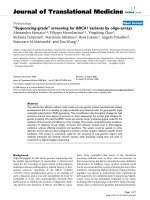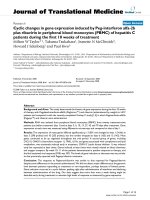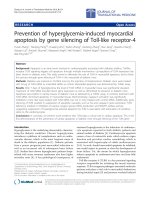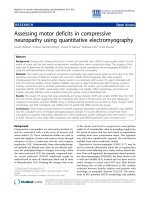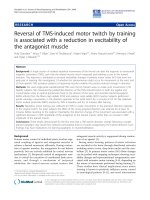Báo cáo hóa học: " Monodisperse upconversion GdF3:Yb, Er rhombi by microwave-assisted synthesis" potx
Bạn đang xem bản rút gọn của tài liệu. Xem và tải ngay bản đầy đủ của tài liệu tại đây (845.35 KB, 5 trang )
NANO EXPRESS Open Access
Monodisperse upconversion GdF
3
:Yb, Er rhombi
by microwave-assisted synthesis
Haiqiao Wang
1*
and Thomas Nann
2
Abstract
We have synthesized a variety of monodisperse colloidal GdF
3
:Yb, Er upconversion nanocrystals with different
shape, size, and dopants by microwave-assisted synthesis. Typical upconversion emission from Er
3+
was observed.
In addition to highly monodisperse spherical particles, we wer e able to prepare monodispersed rhombic-shaped
slices that showed a tendency for self-assembly into stacks.
Introduction
In recent publications we have shown that microwave-
assisted synthesis allows for the preparation of highly
monodisperse, spherical upconversion nanocrystals [1],
as well as na nocrystals with unusual m orphologies [2].
In this research letter, we report on the microwave-
assisted synthesis of monodispersed spherical and
rhombic GdF
3
-based nanoparticles, which show a high
tendency for self-assemb ly in one- and two-dimensional
superstructures.
Research on upconversion nanocrystals increased expo-
nentially over the past several years (e.g., in 2000, one arti-
cle on upconversion nanomaterials was published, in 2009,
it have been 57) as the extre mely attrac tive prospec ts for
applications of these materials in bioanalytics [3], (cancer)
therapy [4], and electro-optics [5]. And subsequently, it is
concluded that the most efficient infrared-to-visible
upconversion phosphors are Yb/Er or Yb/Tm co-doped
fluorides, such as hexagonal phase NaYF
4
[6,7], LaF
3
[8,9],
and orthorhombic phase YF
3
[10], GdF
3
[11]. Especially in
the past few years, the NaYF
4
-based phosphors, as the
highest efficient upconversion phosphors, with different
morphologies and different dopants have been widely
investigated, based on various synthesis procedures. How-
ever, GdF
3
as one of the efficient upconversion phosphor
host [8], not too much work has been reported focusing
on Yb/Er codoped fluorecence upconversion. Although
Tm, Dy, Ho, and Yb/Tm doped GdF
3
has been reported
[11-14]. As far as we know, in 1971, the preparation of
GdF
3
:Yb, Er phosphor was reported firstly by Major et al.
In their procedure, the oxide precursors were dissolved in
high purity nitric acid and precipitated with excess hydro-
fluoric acid, and f inally experienced calcination. They
found that the color of the anti-Stokes luminescence of
the Yb/Er doped GdF
3
phosphors was controllable by pre-
paration processes, and was associated with the crystal
structure of the host lattices. And they gave a dominant
green emission when excited by 940 nm infrared light
[10]. In 2006, Fan et al. employed a hydrothermal synth-
esis procedure to produced Yb/Er codoped GdF
3
nanopar-
ticles. For their prepared sample, typical upconversion
emission was observed but with much weaker intensity
than that of bulk crystal [15].
Microwave-assisted synthesis of nanoma terials offers
several interesting synthetic opportunities which are
based on the specific microwave effects: (i) microwave
irradiation is absorbed by polar and ionic substances only
(dielectric heating); (ii) enhanced reaction rates can be
observed; (iii) heterogeneous heating (viz. “ hot spots” )
and wall effects can be suppressed [16]. Details on the
microwave- assisted synthesis of AYF
4
(A = Na, Li) nano-
crystals can be found elsewhere [1]. This research letter
is concerned with the effects of microwav e irradiation on
the shape evolution of GdF
3
nanocrystals.
In this paper, we firstly presented the preparation of
colloidal upco nversion GdF
3
:Yb, Er nanocrystals, based
on a new microwave-assisted synthesis method. We
have synthesized a variety of GdF
3
-based upconversion
nanocrystals with different shape, size, and dopants by
microwave-assisted synthesis. In addition to highly
monodisperse spherical particles, we were able to
* Correspondence:
1
Institute Materials for Electronics and Energy Technology (I-MEET), Friedrich
Alexander Universität Erlange n-Nürnberg, Marternsstraße 7, 91058, Erlangen,
Germany.
Full list of author information is available at the end of the article
Wang and Nann Nanoscale Research Letters 2011, 6:267
/>© 2011 Wang and Nann; lice nsee Springer. Thi s is an Open Access article distributed under the terms of the Creative Commons
Attribution License ( which permits unrestricted use, distribution, and reproduct ion in
any medium, p rovided the original work is properly cited.
prepare monodisperse rhombic-shaped slices that
showed a tendency for self-assembly into stacks.
Experimental
According to our previous work [1], introducti on of Li
+
can help to en hance the upconversion efficiency. So
here in the procedure, Li
+
was used as well. In a typic al
synthesis (standard conditions), 0.115 mmol (13.8 mg)
lithium trifluoroacetate (TFA), 0.083 mmol (41.2 mg)
gadolinium TFA, 17 μmol (8.5 mg) ytterbium TFA, and
1.7 μmol (0.86 mg ) erbium TFA were dissolved in 6 ml
of a 1:1 (v:v ) mixture of oleic acid and octadecene in a
nitrogen atmosphere. The solution was thoroughly
degassed at 120°C and transferred into a microwave
reaction vessel. Then, the mixture was heated for
10 min at 290°C by microwave irradiation. The result ing
nanocrystals were precipitated by addition of 3 ml of
ethanol to the cold reaction solution and subsequent
centrifugation. The supern atant was discarded and the
nanocrystals were repeatedly washed with ethanol. Even-
tually, the particles were re-dissolved in chloroform or
toluene for further studies.
Transmission electron micrographs (TEMs) were
recorded on a JEOL 2000EX and a JEOL 2010 micro-
scope at 200 kV. Selected area electron diffraction
(SAED) patterns were measured on the same instru-
ment. The X-ray diffraction (XRD) patterns were mea-
sured with a thermo ARL XTRA equipped with a Cu
X-raytube(l = 1.5418 Å). Upconversion spectra were
recorded on an Oceanoptics USB spectrometer and a
home-made cuvette holder and excitation source
(980 nm, 100 mW laser diode).
Results and discussion
Figure 1 shows TEMs of the resulting nanocrystals. It
was observed that the particles were regularly shaped
rhombic plates with approximately 3.2 nm thickness,
approximately 45 nm in length and with a roughly cal-
culated aspect ratio of 1:3. Both micrographs show
clearly that the nanoplates have a strong tendency to
form two-dimensional aggregates. This effect can be
attributed to the minimization in energy, which is
achieved by hydrophobic interaction of the surface
ligands of the nanoparticles at their largest faces.
The XRD pattern of these particles (Figure 2) which
shows orthorhombic phase GdF
3
was obtained. Almost
all the diffraction peaks of the XRD pattern can be
assigned, respectively, to the planes of orthorhomb ic
GdF
3
crystalline (JCPDS-file 012-0788), a s indicated
(101), (020), (111), (210), (002), (221), (112), (301), (230),
(212) in Figure 2 (red, round dot). Ho wever, two more
weak diffraction peaks can also be observed at 2θ =38.7°
and 45°, which cannot be assigned to GdF
3
.Weconsid-
ered that these two weak peaks arose from the diffraction
of LiF (JCPDS-file 045-1 460) [17]. And it suggests that
the Li
+
was not only introduced into the expected phos-
phor GdF
3
crystal to replace some Gd
3+
sites as impurity
but also a few LiF was formed. A further confirmati on of
a predominant GdF
3
lattice can be found by measuring
distances of the lattice fringes in the high resolution
transmission electron microscopy (HRTEM). Lattice
fringes were found with distances of 3.29 and 2.94 Å
(cf. Figure 3B) , corresponding well to the theoretically
calculated distance of the {111} and {210} planes of the
orthorhombic-YF
3
space group GdF
3
(orthorhombic
phase JCPDS-file 012-0788), respectively. It is noteworthy
that the same XRD patterns were observed for decreased
and increased reactant concentrations.
In our previous work, we found that changing the
reaction parame ters (especially the concentration of
reactants) in the synthesis of NaYF
4
-based upconversion
nanocrystals, has crucial influence on the morphology of
the resulting particles [2]. In this work, we observed
that, based on our precursors, GdF
3
nanocrystals were
Figure 1 TEMs of GdF
3
nanocrystals. (A) Overview graph of
single nanocrystals and “stacks”. (B) Blow-up of self-assembled
nanocrystals.
Figure 2 XRD pattern of GdF3 nanocrystals as depicted in
Figure 1. Full circle (red): diffraction pattern according to JCPDS-file
012-0788; full square (green): diffraction pattern according to JCPDS-
file 045-1460.
Wang and Nann Nanoscale Research Letters 2011, 6:267
/>Page 2 of 5
obtained and always adopt a rhombic shape under
microwave irradiation, even when other synthesis para-
meters were changed.
Figure 3 shows TEMs of GdF
3
nanocrystals that were
synthesized under the above conditions, but with 25% of
the original concentration of reactants. The particles are
smaller than the ones displayed in Figure 1 (approxi-
mately 15-18 nm in length), but have roughly the same
thickne ss and aspect ratio. Therefore, the rate of growth
along the “edges” of the particles has to be much faster
as compared to the primary faces ({111} and {210}). Fig-
ure 3B shows a HRTEM of the same particles. It can b e
observed that the lattice fringes are always aligned with
one edge of the rhombi. This observation and the over-
all shape of the nanocrystals are in agreement with the
anticipated orthorhombic-YF
3
space group [18].
When the concentration of reactants was increased by
a factor of five, compared with the standard conditions,
the nanocrystals were still predominantly rhombic in
shape (in addition, some spherical particles were
observed), but approximately 150 nm in length and
5 nm in thickness (cf. Figure 4A). This finding confirms
further that the nanocrystals grow preferentially in two
dimensions. A gain, the XRD pattern is associated well
with the orthorho mbic phase GdF
3
, and without di ffrac-
tion peak s of LiF any more (Figure 4C). Figure 4C inset
shows the SAED pattern of this prepared sample. Figure
4B shows the TEM of the obtained nanocr ystals that
were prepared under identical conditions as the ones in
Figure 4A, but using traditional conductive heating.
Shape and size of these particles are roughly in the
order of magnitude of the standard conditions described
above. However, the XRD pa ttern (inset Figure 4B) of
these nanocrystals shows that mainly cubic LiF nano-
crystals have been synthesized.
Figure 3 TEMs of GdF3 nanocrystals prepared with 25% of the
original concentration of reactants. (A) Overview picture. (B)
High-resolution TEM of single nanocrystals.
Figure 4 TEM, XRD and SAED characterization of obtained samples. (A) TEM micrograph of GdF
3
nanocrystals synthesized at five times the
standard concentration. (B) LiF nanocrystals synthesized by traditional conductive heating at the same conditions like A. Inset: XRD pattern of
the obtained nanocrystals. (C) XRD pattern of GdF
3
nanocrystals synthesized at five times the standard concentration. Inset: SAED pattern of the
prepared sample.
Wang and Nann Nanoscale Research Letters 2011, 6:267
/>Page 3 of 5
Figur e 5 shows the upconver sion emission spectrum of
the nanocrystals from Figure 4A, under 980 nm near
infra-red (NIR) excitation. Mainly two emission bands
were observed, with emission peaks at 521, 545, and 660
nm. These emission peaks can be attributed to the 4f-4f
transitions of the Er
3+
ions. The green emission accounts
for the
2
H
(11/2)
,
4
S
(3/2)
®
4
I
(15/2)
transition, the red emis-
sion is caused by the
4
F
(9/2)
®
4
I
(15/2)
transition. The dif-
ference compared with typical reported Yb/Er emission
spectrum is that a weak red emission at approximately
628 nm was observed, which could be attributed to the
transition
4
I
(9/2)
®
4
I
(15/2)
. Based on Yb/Er cod opants,
the observed upconversion efficiency of the GdF
3
-based
nanocrystals is relatively lower than that of the NaYF
4
-
based nanocrystals in our lab [1]. Comparing these values
with data from the literature shows that the microwave-
assisted synthesis does not influence the optical proper-
ties of the nanocrystals per se.
In order to establish the reason for the strict rhomb ic
shape of the nanocrystals, we replaced lithium with
sodium in the above synthe sis method. Yb/Ho codoped
NaGdF
4
nanocrystals were synthesized under the s ame
conditions as above. Figure 6A shows the TEMs of the
resulting particles with high and low reactant concentra-
tion, respectively. It can be seen that monodisperse,
spherical par ticles were synthesized at low reactant con-
centration, and a bimodal distribution of monodisperse,
spherical, and irregular larger nanocrystals at higher
concentrations. Hence, these particles adopted a com-
pletely different morphology compared with GdF
3
.
Figure 6C shows a XRD pattern of these particles,
which confirms that the nanocrystals have crystallized in
the cub ic a-NaGdF
4
phase (JCPDS 27-697). Therefore,
we can conclude that the rhombic morphology of the
GdF
3
nanocrystals was primarily driven by the crystal
lattice. Under the 980 nm excitation, mainly three emis-
sion bands were observed (Figure 6D). Predominantly
Figure 5 Upconversion spectrum of GdF
3
:Yb, Er nanocrystals
under excitation of 980 nm.
Figure 6 TEMs of NaGdF4:Yb, Ho nanocrystals. (A) Five times standard concentration; (B) 25% standard concentration; (C) XRD pattern of
NaGdF
4
:Yb, Ho nanocrystals; (D) Upconversion spectrum of NaGdF
4
:Yb, Ho nanocrystals under excitation of 980 nm.
Wang and Nann Nanoscale Research Letters 2011, 6:267
/>Page 4 of 5
green upconversion luminescence was observed at 542
nm, corresponding to the transition from the
5
F
4
and
5
S
2
to the
5
I
8
ground state. A weaker red and NIR
upconversion luminescence was observed at 650 and
751 nm, which could be attributed to the transition
from the
5
F
5
®
5
I
8
and
5
F
4
,
5
S
2
®
5
I
7
states, respec-
tively, which is in agreement with data from the
literature.
Conclusions
Our experimental results allow for thre e major conclu-
sions:
1. The presence of lit hium does not impair the pre-
dominant orthorhombic-YF
3
space group of GdF
3
at
all concentrations tested.
2. The crystallization in the orthorhombic-YF
3
space
group and the rhombic shape of the nanoparticles
are specific microwave ef fects. Conductive heating
leads to completely different nanocrystals, a ltho ugh
rhombic in shape.
3. The optical prope rties (viz. upconversi on) of the
nanocrystals seem to be unaffected by the micro-
wave-assisted synthesis method.
Thus, beyond being rapid and easy to use, microwave-
assisted synthesis of upconversion nanocrystals allows
for the crystallization of new nanocrystals and morphol-
ogies. Rhombic plates, like the ones synthesized in our
study, might be key to self-assembly or supramolecular
strategies towards an improvement of the upconversion
quantum yield.
Abbreviations
SAED: selected area electron diffraction; TFA: trifluoroacetate; TEM:
transmission electron microscopy; XRD: X-ray diffraction; HRTEM: high
resolution transmission electron microscopy; NIR: near infra-red.
Acknowledgements
We acknowledge gratefully the financial support of the Deutsche
Forschungsgemeinschaft (DFG project NA 373/7-1) for this work.
Furthermore, we would like to thank Dr Richard D Tilley of the Victoria
University of Wellington, NZ, for the HRTEM measurements. And we also
thank Dr Miroslaw Batentschuk of the University Erlangen for proof reading
of the manuscript.
Author details
1
Institute Materials for Electronics and Energy Technology (I-MEET), Friedrich
Alexander Universität Erlange n-Nürnberg, Marternsstraße 7, 91058, Erlangen,
Germany.
2
Ian Wark Research Institute, University of South Australia, Mawson
Lakes, South Australia 5095, Australia.
Authors’ contributions
WH participated in the design of the study, carried out the synthesis,
analyzed the data, and drafted the manuscript. NT participated in the design
of the study and helped to draft the manuscript All authors read and
approved the final manuscript.
Competing interests
The authors declare that they have no competing interests.
Received: 3 November 2010 Accepted: 29 March 2011
Published: 29 March 2011
References
1. Wang H, Nann T: Monodisperse Upconverting Nanocrystals by
Microwave-Assisted Synthesis. ACS Nano 2009, 3:3804.
2. Wang H, Tilley RD, Nann T: Size and shape evolution of upconverting
nanoparticles using microwave assisted synthesis. CrystEngComm 2010,
12:1993.
3. Wang M, Mi C, Wang W, Liu C, Wu Y, Xu Z, Mao C, Xu S: Immunolabeling
and NIR-Excited Fluorescent Imaging of HeLa Cells by Using NaYF4:Yb,Er
Upconversion Nanoparticles. ACS Nano 2009, 3:1580.
4. Chatterjee DK, Yong Z: Upconverting nanoparticles as nanotransducers
for photodynamic therapy in cancer cells. Nanomedicine 2008, 3:73.
5. Downing E, Hesselink L, Ralston J, Macfarlane R: A Three-Color, Solid-State,
Three-Dimensional Display. Science 1996, 273:1185.
6. Auzel F: Upconversion and Anti-Stokes Processes with f and d Ions in
Solids. Chem Rev 2004, 104:139.
7. Wang F, Liu XG: Recent advances in the chemistry of lanthanide-doped
upconversion nanocrystals. Chem Soc Rev 2009, 38:976.
8. Yi GS, Chow GM: Colloidal LaF3:Yb,Er, LaF3:Yb,Ho and LaF3:Yb,Tm
nanocrystals with multicolor upconversion fluorescence. J Mater Chem
2005, 15:4460.
9. Shen HX, Wang F, Fan XP, Wang MQ: Synthesis of LaF3: Yb3+,Ln3+
nanoparticles with improved upconversion luminescence. J Exp Nanosci
2007, 2:303.
10. Low NMP, Major AL: Effects of preparation on the anti-stokes
luminescence of Er-activated rare-earth phosphors. J Lumin 1971, 4:357.
11. Cao CY, Qin WP, Zhang JS: Study on Upconversion Luminescence and
Luminescent Dynamics of 20%Yb3+, 0.5%Tm3+ Co-Doped YF3 and
GdF3 Nanocrystals. J Nanosci Nanotechnol 2010, 10 :1900.
12. Chen DQ, Wang YS, Yu YL, Huang P: Structure and Optical Spectroscopy
of Eu-Doped Glass Ceramics Containing GdF3 Nanocrystals. J Phys Chem
C 2008, 112:18943.
13. Shan ZF, Chen DQ, Yu YL, Huang P, Lin H, Wan YS: Luminescence in rare
earth-doped transparent glass ceramics containing GdF3 nanocrystals
for lighting applications. J Mater Sci 2010, 45:2775.
14. Wong HT, Chan HLW, Hao JH: Towards pure near-infrared to near-
infrared upconversion of multifunctional GdF3:Yb3+,Tm3+ nanoparticles.
Opt Exp 2010, 18:6123.
15. Fan XP, Pi DB, Wang F, Qiu JR, Wang MQ: Hydrothermal synthesis and
luminescence behavior of lanthanide-doped GdF3 nanoparticles. IEEE
Trans Nanotechnol 2006, 5:123.
16. Kappe CO: Controlled Microwave Heating in Modern Organic Synthesis.
Angew Chem Int Ed 2004, 43:6250.
17. Ranieri IM, Bressiani AHA, Morato SP, Baldochi SL: The phase diagram of
the system LiF-GdF3. J Alloys Compd 2004, 379:95.
18. Zalkin A, Templeton DH: The Crystal Structures of YF3 and Related
Compounds. J Am Chem Soc 1953, 75:2453.
doi:10.1186/1556-276X-6-267
Cite this article as: Wang and Nann: Monodisperse upconversion GdF
3
:
Yb, Er rhombi by microwave-assisted synthesis. Nanoscale Research
Letters 2011 6:267.
Submit your manuscript to a
journal and benefi t from:
7 Convenient online submission
7 Rigorous peer review
7 Immediate publication on acceptance
7 Open access: articles freely available online
7 High visibility within the fi eld
7 Retaining the copyright to your article
Submit your next manuscript at 7 springeropen.com
Wang and Nann Nanoscale Research Letters 2011, 6:267
/>Page 5 of 5
